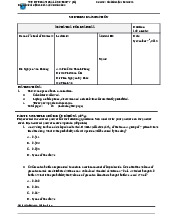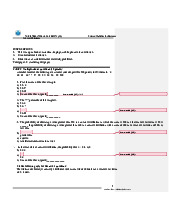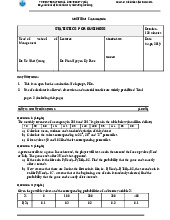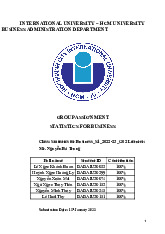





Preview text:
ASBE 5e Solutions for Instructors Chapter 1 Overview of Statistics 1.1
a. Statistics can be used to 1) determine what a typical commission is and then 2) use that
value to identify commissions that appear to be unusually high.
b. She could use statistics to show the average energy use compared to previous models.
She could also use statistics to show how durable the monitor would be in the field.
c. He could use statistics to calculate the average absenteeism at each plant and then
compare across the three plants.
d. He could calculate average number of defects in each shipment. He could determine
variation in number of defects between the three shipments.
Learning Objective: 01-1 1.2
a. He could calculate the job turnover for each gender for each restaurant. He could then
look at the difference between the various restaurants as well as the difference between genders.
b. He could calculate the average number of emails received and sent for employees in
different job classifications and make comparisons.
c. The portfolio manager could calculate both the average return and the variation on return
for the six different investments and make comparisons.
d. By studying the busiest times of day for surgery, the administrator could work with
surgeons to spread their surgeries out to better use the facilities. He might also look at
which surgeries take the longest and which are shorter to help with scheduling.
Learning Objective: 01-1 1.3
a. The average business school graduate should expect to use computers to manipulate the data.
b. Answers will vary. Weak quantitative skills lead to poor decision making because data-
based decision making is a hallmark of successful businesses. If one cannot analyze
data or understand summary analyses, one will be making decisions without full information.
Learning Objective: 01-2 1.4
a. Answers will vary. Why Not Study: It is difficult to become a statistical “expert” after
taking one introductory college course. A business person should hire statistical experts
and have faith that those who are using statistics are doing it correctly. Why Study: In
fact, most college graduates will use statistics every day. Relying on a consultant to
perform simple or even complex statistical analyses means turning over part of the
business decision-making to someone who doesn’t know your business as well as you do.
b. Answers will vary. Answers provided in part a will be similar for the subjects of
accounting. Foreign languages are essential in this global business environment of
today. While learning a foreign language can take considerably more time as an adult, 1
the investment is worth it. Businesses are looking for college graduates that have
quantitative skills and speak a foreign language. Chinese and Spanish are popular choices.
c. To arrive at an absurd result, and then conclude the original assumption must have been
wrong, since it gave us this absurd result. This is also known as proof by contradiction.
It makes use of the law of excluded middle — a statement which cannot be false, must
then be true. If you state that you will never use statistics in your business profession
then you might conclude that you shouldn’t study statistics. However, the original
assumption of never using statistics is wrong; therefore the conclusion of not needing to
study statistics is also wrong.
Learning Objective: 01-2 1.5 a. Answers will vary.
b. An hour with an expert at the beginning of a project could be the smartest move a
manager can make. A consultant is helpful when your team lacks certain critical skills,
or when an unbiased or informed view cannot be found inside your organization.
Expert consultants can handle domineering or indecisive team members, personality
clashes, fears about adverse findings, and local politics. As in any business decision, the
costs of paying for statistical assistance must be weighed against the benefits. Costs
are: statistician’s time, more time invested in the beginning of a project which may
mean results are not immediate. Benefits include: better sampling strategies which can
result in more useful data, a better understanding of what information can be extracted
from the data, greater confidence in the results.
Learning Objective: 01-2 1.6
a. The ethical issue is that credit card companies are using unfair marketing practices to
entice students to use credit cards. Students are a vulnerable group that has not been
educated about personal finance. Credit card companies are also purchasing student
lists from universities and various student groups. This is also an unethical practice by the universities.
b. They used an in-person survey given to 1500 students. These students were randomly
solicited at popular places on campus. The sampling technique was a convenience
sample. The report did not attempt to make inferences about the population of college
students. The report simply provided statistics collected from their sample. The naïve
reader would most likely make the inference that the numbers from the sample apply to
the population as a whole. This should be made clearer in the report.
c. The subjects surveyed include 1) how students pay for their education, 2) how they use
credit cards, 3) how many of them use credit cards, and 4) attitudes toward credit card
marketing on campus. It would be interesting to see what the questions were and how they were worded.
d. Because the survey focused on students’ opinions and did not provide information about
credit card use by the general population it is difficult to conclude that the marketing
practices companies use on campuses are different from those used to market cards to
the general public. Furthermore, it was not obvious that those students who had credit
cards obtained those cards as a direct result of the campus marketing efforts. What was
impressive was the amount of research the group did to support their claims of 2
unethical practices. The references to other reports and court cases were a better support
for their claims in question 1.
e. Answers vary. In general, because the study was based on a convenience sample the
results cannot be assumed to hold for the general population of students. Also, it would
be good to know how students’ use of credit cards compares to the general public.
f. The list of schools included in the survey is focused in a few states such as
Massachusetts, California, and Colorado. There were very few schools from the
southeast and virtually no private colleges or universities. Because it was a convenience
sample it is not appropriate to extend the results from the survey to the larger
population of college students. However, many of the references cited did suggest that the problem was widespread.
g. First, they suggest eliminating "freebies" or gifts that would entice students to sign up
for a credit card. Second, they suggest limiting posted marketing materials on campus.
The third solution is to disallow acquisition of students’ lists. Fourth, they suggest that
sponsorship should be discontinued. In other words, credit card companies cannot pay
for student groups to get them new customers. The fifth recommendation is to enhance
student awareness about credit card problems. Finally, they suggest that certain terms
that take advantage of students should be discouraged. For example, hidden fees,
changing contracts, and universal default should be eliminated.
As a follow up to this report note that the Credit Card Accountability Responsibility and Disclosure Act of 2009 Credit C or
ARD Act of 2009 is a federal law passed by the
United States Congress and signed by President Barack Obama on May 22, 2009. It is
comprehensive credit card reform legislation that aims "...to establish fair and
transparent practices relating to the extension of credit under an open end consumer
credit plan, and for other purposes."[1]
Learning Objective: 01-3 1.7
Answers will vary. Examples include: linking expectations on conduct to the company’s
mission, explaining what is considered acceptable and unacceptable behavior,
providing courses of action for employees when they have questions or believe an
ethical guideline has been violated, documentation so that employees will know the
code, addressing nepotism, addressing romantic relationships, addressing customer
relationships and vendor relationships.
Learning Objective: 01-3 1.8
Mary is falling for Pitfall 3: Conclusions from Rare Events. Just because an event is
unlikely doesn’t mean it will never happen. The probability may be small but there is a
chance of observing the same five winning numbers in the same sequence on two different days.
Learning Objective: 01-4 1.9
Bob is falling for Pitfall 5: Assuming a Causal Link. Statistical association does not prove
causation. Bob also appears to be falling for Pitfall 6: Generalization to Individuals.
Even if there were a link between cell phones and binge drinking, the link would be
between groups of cell phone users and groups of binge drinkers, not necessarily a one to one link. 3
Learning Objective: 01-4 1.10
a. It is not obvious that there is a direct cause and effect relationship between an individual
choosing to use a radar detector and that individual choosing to vote and wear a seatbelt.
b. Increasing the use of radar detectors may not influence those who obey laws and are less
concerned with government limitations.
Learning Objective: 01-4 1.11
a. No, the method did not “work” in the sense that he increased his chances of winning by
picking the numbers the way he did. Every combination of six numbers has the same
chance of winning. The fact that this winner chose his numbers based on his families’
birthdays and school grade does not increase the chance of him winning.
b. Someone who picks 1-2-3-4-5-6 has just as much chance of winning as anyone else (see (a)).
Learning Objective: 01-4 1.12
a. The phrase “much more” is not quantified. The study report is not mentioned. There is no
way to determine the veracity of this statement. Six causes of car accidents could be
poor weather, road construction, heavy traffic, inexperienced driver, engine failure, and
drinking. Smoking is not on this list.
b. Smokers might pay less attention to driving when lighting a cigarette.
Learning Objective: 01-4 1.13
The percent reduction might not seem important because it appears so small but when
multiplied by millions of calls each day it does translate into a significant improvement.
Learning Objective: 01-4 1.14
a. The conclusion was a broad generalization. This can cause ethical issues if action was
taken against employees that had legitimate complaints about management decisions.
b. The sample is too small, and non-random, creating bias.
c. This test is only going to be performed in the laboratory which limits the ability to see
how it works out in the world. Additionally, there is no informed consent.
d. The sample is once again way too small and is non random. This again creates bias which creates no causal link.
Learning Objective: 01-4 1.15
Sarah’s statement is not correct. Most people would feel the difference is practically
important. 0.9% of 231,164 is 2,080 patients.
Learning Objective: 01-4 1.16
The headline implies causation but we cannot assume causation just because the repeal
came before the increase in deaths. The deaths could have been going up each year
before this study or there could be other variables contributing to the increase in deaths.
Although the research accounts for some third variables such as increased registrations, it does not prove causality. 4
Learning Objective: 01-4 1.17
a. Many people have math “phobia”, and because statistics involves math the subject can
sound scary. The subject of statistics has a reputation for being difficult and this can cause fear of the unknown.
b. There is usually not the same fear towards an ethics class. This is because there is much
more emphasis on unethical behavior in the media, to the extent that ethical behavior
and an understanding of how to be ethical is widely accepted as a requirement to graduate and then succeed.
Learning Objective: 01-2 1.18
Random sampling of cans of sauce for a specific manufacturer can be used to assess quality control.
Learning Objective: 01-1 1.19
a. The consultant can analyze the responses from the 80 purchasing managers noting that
the linen supplier should not make any conclusions about the managers who did not
respond. The consultant should not use the responses to ambiguous questions. She
should suggest that the supplier redesign both the survey questions and the survey
methods to increase the response rates.
b. An imperfect analysis would be a mistake because the supplier may make changes to
their business that upset those customers not responding to the survey or those customers not sent a survey.
Learning Objective: 01-1 1.20
All of these involve taking samples from the population of interest and estimating the value
of the variable of interest (e.g., average height, average width of a car, etc.)
Learning Objective: 01-1 1.21
Hannah’s statement is correct in the sense that we should not use the percentage to describe
the population of all musicians. This was not a random sample. It is merely a statistic
that describes this group of deceased musicians. She correctly recognized Pitfall 2:
Making conclusions from nonrandom samples.
Learning Objective: 01-4 1.22
Sarah is falling for Pitfalls 5 and 6. A statistical association does not mean causation. And
even if there were evidence to support cause and effect, extending the result about
groups to an individual is not appropriate.
Learning Objective: 01-4 1.23
Tom is falling for Pitfall 2: Conclusions from Nonrandom Samples. Tom’s team is a
nonrandom sample. In order to conclude that helmets are not needed, Tom would need
to take a random sample of lacrosse players from several age groups, ability levels, and geographies.
Learning Objective: 01-4 5 1.24
Just because it is not statistically significant does not mean it is not important. Reducing
the risk of death from prostate cancer is extremely important even if it is a small
reduction. Something can also be statistically significant without being important.
Learning Objective: 01-4 1.25
a. Class attendance, time spent studying, natural ability of student, interest level in subject,
instructor’s ability, or performance in course prerequisites. Smoking is not on the list.
b. Most likely students who earn A’s are also making good decisions about their health.
Students who smoke might also be making poor choices surrounding their study habits.
c. Giving up smoking alone may not stop a student from using poor study habits nor is it
likely to increase their interest in a topic.
Learning Objective: 01-4 1.26
Curiosity, parents’ who smoke, friends who smoke, seeing teenagers smoke in movies and
TV, boredom, wanting to look cool. Yes, seeing movie and TV stars smoking was on the list.
Learning Objective: 01-4 1.27
a. We need to know the total number of philosophy majors to evaluate this.
b. We don’t know the number of students in each major from this table.
c. This statement suffers from self-selection bias. There are likely many more marketing
majors who choose to take the GMAT and therefore a wider range of abilities than the
abilities of physics majors who choose to take the GMAT.
d. The GMAT is just one indicator of managerial skill and ability. It is not the only
predictor of success in management.
Learning Objective: 01-4 1.28
a. The graph is much more useful. We can clearly see that as square feet in the restaurant
increases, so does interior seats. It is a fairly strong linear relationship.
b. The last three data points on the far right show restaurants that have large square feet as
well as a lot of interior seats. The point all the way to the left shows the opposite, small
square footage with hardly any interior seats.
Learning Objective: 01-1 1.29
a. The graph is more helpful. The visual illustration allows you to quickly see the results
and the obvious decline in salad sales.
b. We can quickly see that the month of May saw most salads sold, while the month of
December saw the least salads sold.
Learning Objective: 01-1 1.30 Answers will vary.
Learning Objective: 01-4 6




